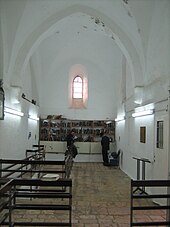St. Samuel Abbey
St. Samuel (also: Monjoie ) was a Premonstratensian abbey in the Kingdom of Jerusalem founded by the Crusaders . The abbey was built on the site where, according to tradition, the prophet Samuel was buried. Today there is a mosque on the site of the prophet's tomb in the village of Nabi Samwil in the West Bank . The crypt of the previous church is now used as a synagogue.
history
The crusaders called the hill of Samuel's tomb Mons gaudii , French Montjoie (mountain of joy). According to tradition, it was from here that they saw the holy city for the first time on their way to Jerusalem. King Baldwin II gave the place of the grave to St. Bernard of Clairvaux as well as 1000 gold pieces for the construction of a Cistercian monastery . Bernhard refused the gift and offered it to the Abbot of Prémontré in a letter in 1150 . St. Samuel eventually became a direct subsidiary of the Prémontré Abbey. The abbots of St. Samuel had suffragan status to the Latin Patriarch of Jerusalem. 1185 the rights and possessions were the Abbey by King Baldwin V confirmed. In 1187 the monastery was conquered by Sultan Saladin. The Premonstratensians fled to Acre , where the convent continued to exist in the subsidiary founding of St. Samuel until the city fell in 1291.
In the 17th century the ruins of the church were converted into a mosque. In 1912 it was almost completely rebuilt, which was badly damaged by Turkish artillery in 1917 and was later rebuilt.
Construction and plant
St. Samuel had a cross-shaped abbey church, which probably closed with a semicircular apse in the east. To the north of the nave, the church had a side aisle-like extension with access to Samuel's grave, the core of which has been preserved.
literature
- Denys Pringle: The Churches of the Crusader Kingdom of Jerusalem, Volume 2 , Cambridge University Press 1998, pp. 85-93.
Footnotes
- ↑ Zwi Werblowsky: The Meaning of Jerusalem to Jews, Christians and Muslims . In: Institute for Christian and Jewish Studies (ed.): Holy Land, Contested Land , Volume 3.
- ^ Herbert Lockwood Willett: Jerusalem . In: The Biblical World , Vol. 26 (1905), pp. 325-335, here p. 326.
Coordinates: 31 ° 49 ′ 58 " N , 35 ° 10 ′ 49.1" E
